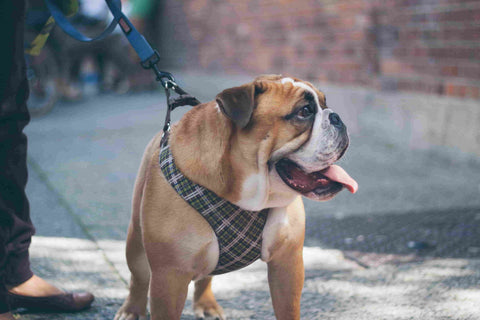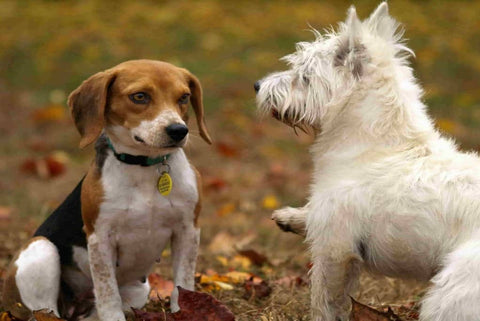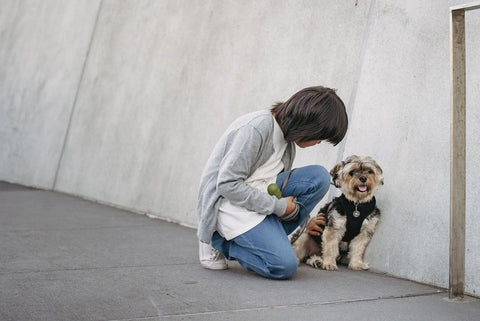Which is the Best Retractable Dog Leash?
When it comes time to purchase a new retractable dog leash, it’s important to make the right decision.
After all, what’s more important than ensuring your furry best friend is able to take the most fun, safest, and best possible walks? You wouldn't want to settle for a second or third rate leash!
You've already spent hours reviewing all the Pros and Cons of Retractable Dog Leashes, determined that Retractable Leashes are Better, but which one should you buy?
While safety should certainly be the top priority for any responsible dog owner or dog walker, there are other factors about retractable leashes that you'll need to take into consideration as well, like convenience, flexibility and ease of use.
Because if you don’t actually enjoy walking your dog, then how often are you actually likely to hook them up and take them for a stroll?
With that said, let’s go through all the things you should be thinking about when choosing the right retractable dog leash!
Factors to Consider when Shopping for a Retractable Dog Leash
Durability
Out of all the factors you should consider when determining which retractable dog leash to buy, durability should top the list. After all, what’s the point of a retractable dog leash that won’t hold up over time?
If you’re got a bigger, stronger, or pulling dog, you’re going to want to get a stronger, more rugged tool. If you walk under stressful conditions, like high winds, rain, snow, sleet, or freezing cold, then you’ll want the type of handle that can hold up to adverse weather.
Think about where you walk, what kind of abuse you put your gear through while walking, and then pick a handle that’s appropriate for your typical use.
The Handle
As the Handle is what you’ll be interacting with most, you should certainly pay close attention to the size, shape and grip of the handle. Is it hard plastic, rubberized, ergonomic, angled to help you easily control a pulling dog?
Think about how you prefer to hold your leash as you walk your dog; do you hold it up near your chest or shoulders, in front of your heart, at your hips, or would you prefer to be able to simply clip the handle to a belt, a shoulder strap, or some other attachment? Will you be walking under the hot sun, or in rainstorms?
Do you need to worry about the handle heating up, or being too cold? Pick a handle that’s versatile, but suited to your most common walking conditions, shaped appropriately for however you prefer to hold it, and sized to fit comfortable in your hands.
Clip Type
It should swivel, otherwise your leash will end up twisting around itself, perhaps even tying into knots. You definitely need a swivel clip to prevent tangles and break the retractability of the leash itself.
But you should also look for a clip that’s easy to open for when you want to attach it to your dog’s collar (or harness!), and one that will also remain securely shut, even when tension is put against it. Make sure it’s strong enough that it won’t give, bend, or break, as that would obviously be an incredible safety threat.
And try to pick a clip that’s the appropriate size for your dog too – you wouldn’t want him or her to have to drag a huge clip around if they’re tiny, but you also don’t want an undersized clip that isn’t strong enough to hold your big guy or girl securely either.
Leash Style
Do you want a cord, a ribbon or a tape-style leash? There is a difference, as corded leashes may work fine for really small dogs, but ribbons are much more durable, much more likely to last through rugged use, and last longer as well.
Anyone who has owned the cord-style retractable dog leash has likely experience some kind of failure, whether that’s simple fraying that caused you to abandon the leash, or an actual snap during a walk, those of us with lots of dog-walking and retractable leash experience know that the ribbon or tape-style retractable dog leash is much more likely to last.
Leash Length
How much length do you really need on a regular basis? And what’s allowed where you live and typically walk? Some cities have passed really restrictive laws over dog leashes, targeting retractable leash users, and literally banning leashes longer than 6 feet in length.
If you live in an area with a leash length ban, make sure you’re aware of it, and choose accordingly. For those of us who live in unrestricted zones, we’re able to pick and choose based on whatever we feel is most comfortable.
How much room do you want to give your dog to explore? Do you typically walk down the sidewalk, on a busy street, with lots of pedestrian or other traffic? Or are you walking in the country, in a wide open park or field? The more space you have available on your walks, and the less traffic, the longer you can go.
Our suggestion is to get a longer leash (around 16 feet in length), since you can set the break to prevent it from going longer than you like, but having the extra length gives additional flexibility, giving you the choice of letting your furry friend roam further afield when it’s safe to do so.
Weight Limit
How much does your dog weigh, and how heavy a leash do you feel comfortable carrying? Like any other piece of equipment, it’s best not to put too much strain on your gear, so if you’ve got a 100 pound dog, then a leash rated to 100 pounds probably won’t be enough, but a 110 pound rating probably provides enough coverage that you’ll be just fine.
Think about how aggressive or how powerful your dog is too, and don’t only take their weight into consideration. Do you have a 35 pound tank who pulls, lunges and tries to take off after every person, dog, or squirrel they see? Go for a stronger, higher rated leash!
Is your dog 100 pounds, but a gentle giant who’s never pulled before, and wouldn’t lunge even for treats? You may be fine to downsize for a lower weight limit leash, as long as you’re certain your dog’s behavior remains consistent regardless of the situation.
Our advice? If you have a calm, gentle, well-behaved dog, then opt for a leash with at least 5-10 pounds past your dogs actual weight to give yourself some wiggle room, just in case. If your dog is known to get aggressive, give yourself more of a cushion, and get a leash rated 20 or more pounds over their weight.
Brake Controls
The whole point of using a retractable leash is that it offers additional flexibility, so you should use a retractable dog leash that provides a quality brake control.
Brake controls allow you to set an upper limit on how far the leash is able to extend. This gives you the choice to provide Fido with 3, 6, 10, or maybe up to as many as 15 or more feet of room to explore.
Typically, the leash will have at least some tension on it, so that it will auto-retract should your dog choose to remain closer than the maximum allowable length you’ve set the brake at.
This reduces the chances of tangles, getting the leash wrapped under your dogs legs, or around other obstacles in the environment.
Lock Controls
Some retractable dog leashes also offer a lock control, which is slightly different from a brake control, letting you set the length of the leash at an exact length, instead of setting a maximum limit.
It’s debatable whether or not this is a good idea, as it can be dangerous to give your dog more room to roam than they want, since that increases the chances of tangles, which could lead to dangerous situations.
We recommend avoiding the use of lock controls since they offer more freedom than traditional brake control, but at the expense of added risk.
Anything that increases the chances of a tangle or snare means adding unnecessary risk to your dog’s favorite pastime, so we think locks should be avoided.
Tangle-Free Design
The highest quality retractable dog leashes offer the ability to keep the cord, ribbon or tape that extends from the leash from wrapping around itself, or around internal mechanisms in the handle, ensuring that you won’t end up tangled.
This is an important safety feature that all retractable dog leashes should offer, but which may be missing from cheaper models. We absolutely recommend reviewing the features on any retractable leash you’re considering and ensuring that you purchase one which offers a tangle-free system.
Daytime vs. Nighttime Use
Will you be walking your dog during the day, at night, during sunsets or sunrises, or in adverse conditions like rain, fog or even snow?
The worse the weather and the lower the light, the more features you may want in your retractable dog leash. Some leashes come with built-in lights, some come with reflective materials, while others don’t.
Why wouldn’t a leash offer these features? Because the vast majority of people who walk their dogs typically don’t need them, as they walk in good weather conditions and wouldn’t even consider leaving the house under adverse conditions.
Keep in mind that you don’t want to pay a premium for a feature set that you’re unlikely to ever use, so if you really don’t walk your dog at night, in the dark, or under inclement weather, then you don’t really need those additional features.
Single Dogs vs. Multiple Dogs
It’s possible to get a retractable dog leash with multiple cords, ribbons or tapes, allowing you to hook up two (or even more) dogs at the same time, but these add a great deal of complexity into the system, and a ton of additional risk for you and your dogs.
The threat of tangles and safety concerns rises dramatically when multiple dogs are involved, especially if they’re both connected to the very same handle, so our advice is to avoid multiple tapes or ribbons on a single leash, and to instead use two separate leashes want to allow retractability for multiple dogs at the same time.
Which Retractable Dog Leash Should I Buy?
We’ve designed Pet&Cuddle’s retractable dog leashes to suit the needs of 99% of dog walkers, providing you with a safe, comfortable, reliable product at a great price.
Our leashes are rugged enough to handle most adverse conditions, strong enough to keep your furry friend from breaking free or getting into trouble, and comfortable to use so you’ll want to keep taking those daily (or multi-daily!) walks.
Shop Pet&Cuddle’s excellent assortment of retractable dog leashes, collars and harnesses!
Common Questions About Retractable Dog Leashes
Still have a few questions about choosing the best retractable leash for your dog? We’ve got you covered. Below are some of the most commonly asked questions about a retractable dog leash and its safe yet comfortable use.
What is a Retractable Dog Leash?
A retractable dog leash is a leash that lets you adjust the length of the line between you and your dog’s collar or harness, giving you and the dog more flexibility to adjust the spacing between each other. Instead of limiting your dog to only 6 or 10 feet of exploration, retractable leashes can provide up to 16 feet or more of range.
How do Retractable Dog Leashes Work?
Retractable dog leashes operate on the principle of providing your dog with an extendable, flexible leash length, giving them more freedom and space to explore their environment, and preventing you from having to constantly fold, tuck, or otherwise adjust a static-length leash in order to prevent it from wrapping up your dog’s legs, or around other objects in the environment.
How Long are Retractable Dog Leashes?
Lengths for retractable dog leashes range, with some running up to 26 feet or more, but the longer the leash gets, the less control you’ll have over your dog and the less safe your walks will become. We recommend opting for a relatively shorter, safer length, choosing a leash length around 16 feet, which provides plenty of room to roam, while offering enough control to keep fido out of trouble.
Are Retractable Dog Leashes Dangerous?
Some people do argue that retractable dog leashes are dangerous, but they’re like virtually any other product; when used responsibly, they’re perfectly safe. Under many conditions and situations, a retractable leash is safer than a standard, static-length leash, as the retractability prevents you (the leash holder) from having to do as much work to manually control the length of the leash, allowing you to adjust based on the conditions required for whatever situation you’re facing.
Are Retractable Leashes Safe?
While the Internet has plenty of articles talking about how rectractable leashes are bad for dogs, we simply don't agree that this is the case. Under most conditions and with most dogs, yes, retractable leashes are perfectly safe. And as we just mentioned in the section above, retractable leashes can be even safer than standard fixed-length leashes, depending on circumstances. If you have issues keeping your fixed-length leash from wrapping up underneath or around your dogs legs, then you may want to try using a retractable leash instead, as the automatic length adjustment they offer could make for safer walking conditions for you and your dog.
Are Retractable Leashes Legal?
That depends on where you’re located. Retractable dog leashes typically aren’t banned, but some counties, cities or parks do ban leashes over a certain length. When leash limit laws are in place, it’s important to be aware of them and to abide by them. In certain situations, a retractable dog leash may be illegal not because it’s retractable, but simply because it offers the flexibility to run longer than the local laws allow.
Why Use a Retractable Dog Leash?
Retractable dog leashes are more flexible, more convenient, and typically, more enjoyable than fixed-length dog leashes. They require less adjustment, and offer greater freedom to your furry friend, making dog walks more fun and thus more likely to occur more frequently than a fixed-length leash.






